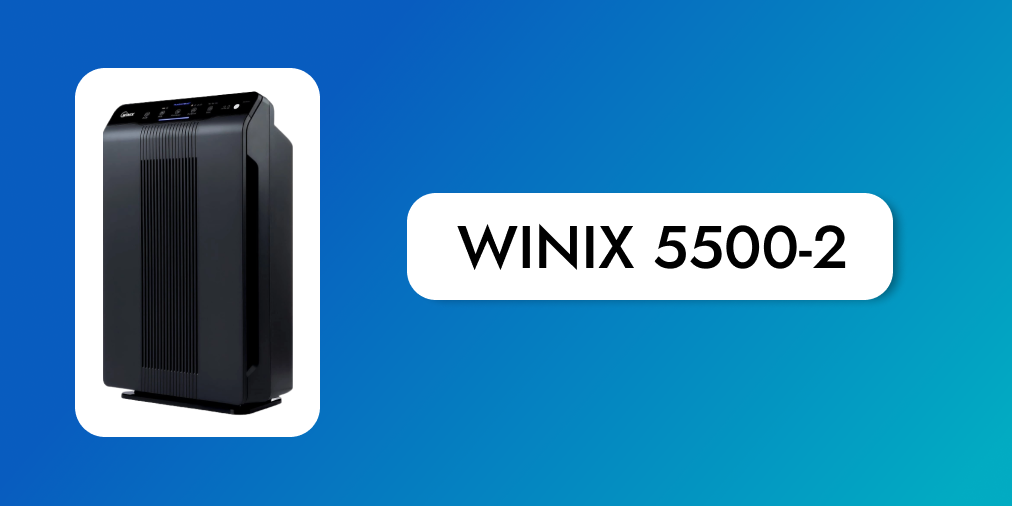The Winix 5500-2 is a highly successful air purifier that has been able to take home Amazon’s Choice Award. Made by the Korean company Winix, this device aims at being one of their most popular products ever made and will be reviewing it today with an insight into why they deserve such success in both name recognition as well quality control measures taken when making these appliances!
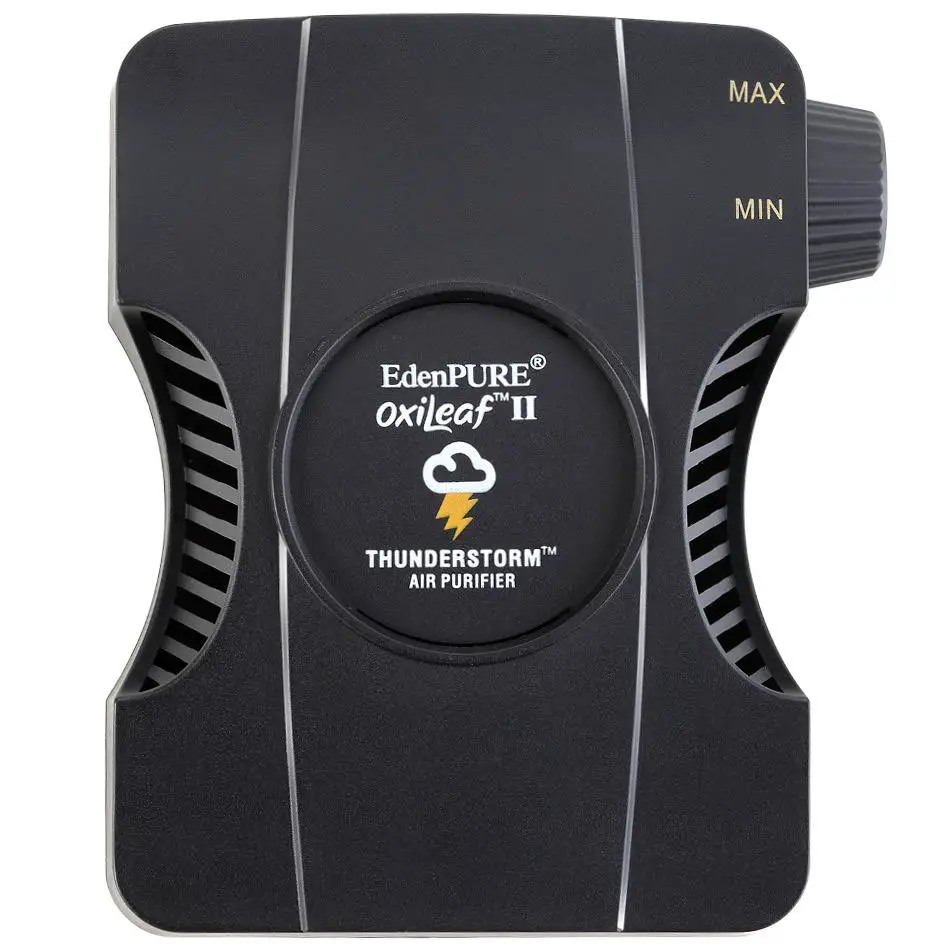
Edenpure Oxileaf II Thunderstorm
Edenpure Oxileaf II Thunderstorm air purifier is just the perfect choice for indoor pollution
Winix 5500-2 Design
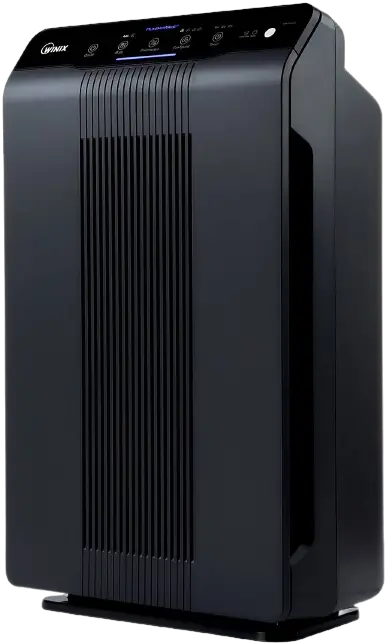
Features
- Color: Charcoal Gray
- Product Dimensions: 7.8″D x 14.9″W x 23.6″H
- Item Weight: 15.4 Pounds
- Control Method: App
- Wattage:
The 5500-2 is a nicely-designed air purifier. It contains a plastic body covered with a luxury Black color, so it doesn’t look cheap like its previous Winix 5300-2 or even the later Winix WAC9500. The fact that an air purifier needs to be plugged in all day makes it better to be plastic than metal.
We will have 5 buttons on the front. The button is more accessible to press than Winix WAC9500. There is one LED Smart Sensor with 3 different colors to show your room’s current air quality.
Also, from the front of 5500-2, there is an intake grill to bring in the air. Winix manufacturers have said clearly in the manual that you shouldn’t put your product near windows or in direct sunlight to avoid product failure.
The outlet air duct on this 5500-2 is located on the top of the device, like other classic air purifiers. However, I think the air vent is a bit leaning to the back, making it challenging to direct the airflow to users.
The 5500-2 has two handles on the sides, making it easy to move around the house. It only weighs 15.4 lbs, so you can easily carry it to where you need it. The buttons are nearly at the top, making them easy to reach and use. This is different from the Winix WAC9500, which has buttons that are harder to reach.
There is one recommendation: you should put the 5500-2 on a hard surface. For our comfort, you can also put Winix 5500-2 on a side table.
Winix 5500-2 Usability
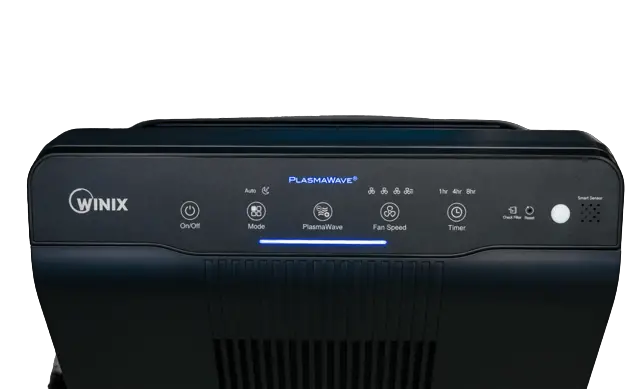
The 5500-2 is a bit more advanced than other models we’ve seen; The 5500-2 has control panel lights that you cannot turn off. The unit does have a sleep mode, but on sleep mode, you give up all manual control of the unit (like setting the fan speed), and one LED still illuminates – the light that shows that sleep mode is activated.
The Coway Mighty and the Winix have lights on their control panels that cannot be turned off. These lights indicate what setting is activated and the overall air quality in the room. These lights cannot be turned off. The only way to make them go away is to unplug the machine.
Some units on the market allow you to control the lights in your home with a full control panel. The Honeywell HPA series (including the HPA100) and all air purifiers manufactured by Levoit have this functionality. However, these units have other significant drawbacks.
You can turn the lights off on their control panel, but you will have to make other big sacrifices to be more energy-efficient and make less noise.
The 5500-2 is one of the larger air purifiers we tested. But it’s not a large or heavy appliance. It is only about 2 ft. tall, a little over an ft. wide, and well under an ft. deep. It only weighs about 16.5 lb., so it’s easy to pick up and move around from room to room or into/out of storage.
There are smaller, lighter options available. The Coway Mighty is about 4 lb. lighter and half an ft. shorter, but it is slightly broader and deeper than the Winix. Smaller units like the Honeywell HPA100 or GermGuardian AC4825 are under 10 lb. and physically smaller as well.
The more costly choices we’ve discussed throughout this review – the Austin HealthMate and IQAir HealthPro Plus – are much heavier and a little larger. Their weight – 35 and 47 lb. respectively – is mostly due to their more powerful gas filtration media.
The Winix 5500-2 has all the features you would expect in an air purifier at its price point. This includes a timer, air quality sensor and display, auto mode, and sleep mode. The Coway Mighty offers the same functionality as the 5500-2. However, the 5500-2 has a remote control while the Coway Mighty and Winix 5300-2 do not.
Winix 5500-2 Filters
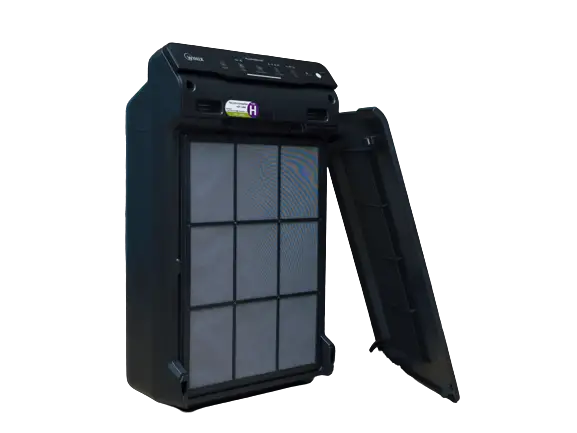
Particle Filter
The Winix 5500-2 has a HEPA filter which filters out things like mold spores, allergens, and dust from the air. The unit has three different filters – one to get rid of particles, one to get rid of gases, and one to get rid of large particles and fibers. The HEPA filter is the first in this list – it’s the primary particle filter.
HEPA filters are the most ordinary type of particle filter used in air purifiers. High-end units like the IQAir HealthPro Plus and Austin Air HealthMate use the same type of particle filter as the Winix – a HEPA filter. Lower-end units like the GermGuardian AC4825 also often use HEPA filters. The AC4825 is provided with a HEPA filter.
All of these units have HEPA filters that work the same way and are just as efficient. A HEPA filter traps 99.97% of the particles that go through it. This efficiency is the same no matter which model you have, whether it is an IQAir for $900 or a GermGuardian for $90. The difference between these models is in other areas – like output or gas filtration quality – not particle filtration quality.
Winix’s HEPA filter is good at removing particles. That is why it is the industry standard. But don’t expect Winix’s filter to be better than other filters of the same type, like the one in Winix 5300-2 or Coway Mighty. They all provide very similar particle filtration quality.
Gas Filter

The 5500-2 air purifier is similar to other air purifiers. It uses a carbon filter to remove gases like VOCs and odors. However, the carbon filter in this purifier has actual carbon pellets. The pellets are held inside a plastic honeycomb-like frame.
Most further units on the market, especially at the same or lower price points, have carbon filters that are not as effective as the pellet-based type for removing gases.
If you are looking for an air purifier that filters out gases, the Winix 5500-2 is a good choice. It uses a pellet-based carbon filter. The Winix 5300-2 and Coway Mighty do not use this type of carbon filter, so they don’t filter out gases as well.
If you are very concerned about gas filtration, you might want to consider an IQAir HealthPro Plus or an Austin Air HealthMate. These units also have carbon filters that contain actual carbon pellets. However, their carbon filters contain more carbon pellets than Winix’s carbon filter. This greater quantity of carbon pellets adsorbs more unwanted gases, which makes the filter last longer.
The HealthPro Plus’s carbon filter has more carbon in it than the Winix. Austin’s filter has more carbon in it than Winix’s. This all costs more money. The IQAir retails for more money than the Winix and the Austin for more money than the Winix. The Winix is a great option for high-quality gas filtration at its price point. The bottom line is that it outperforms competitors at the same price point. However, there are even better options available, but they come at a greater cost.
Pre-filter
The 5500-2 model has a mesh pre-filter to stop larger particles and fibers from getting to the unit’s primary particle filter. The HEPA filter has to be replaced, which can be expensive. The pre-filter can be brushed, vacuumed, or rinsed for free. The pre-filter saves you money over the life of the air purifier. The pre-filter extends the life of the HEPA filter. The HEPA filter would otherwise get dirty quickly and would need to be replaced more often at a higher cost.
The Winix 5300-2 and Coway Mighty have a washable pre-filter. The Coway AirMega does too.
More affordable units normally don’t have a washable pre-filter. Something like the GermGuardian AC4825 only has a HEPA filter and a fibrous carbon filter. The carbon filter has to do two jobs: remove gases and remove larger particles. The problem is that when the filter becomes saturated with these larger particles, it needs to be replaced at a cost.
Unit models like the Austin Air HealthMate and certain IQAir units come with pre-filters that are more effective in removing particles from the air. These pre-filters need to be replaced, and this can be expensive. But keep in mind that the last line of defense is still the HEPA filter, just like it is on the Winix. So even though the air traveling between the pre-filter and HEPA filter is cleaner on these units, the air traveling out of the unit and into the ambient air is just as clean.
Air performance
The Winix 5500-2 lowered the number of particles in the air from 10,000 per cubic ft. to 1,000 per cubic ft. in 9 minutes in a 150 sq. ft. test environment.
Two things affect how well an air purifier does in this test: the quality of the particle filter and how much air the purifier can process in a minute.
- The quality of the particle filter is usually measured by how good it is at trapping particles (such as dust, pollen, and smoke).
- The amount of air an air purifier can process in a minute is usually measured in cubic feet per minute (CFM).
So this indicates that the Winix 5300-2’s HEPA filter and 250 CFM work together to clean the air in our test room in only 9 minutes. The Winix 5300-2 also has a HEPA filter and outputs at approx. 250 CFM, so it’s not surprising that it had the same result as our test – 9 minutes to clean the air in our test room.
The Coway Mighty is a powerful HEPA-equipped unit that can clean the air in a room very quickly. We found that smaller units with less CFM took longer to clean the air, while larger units with more CFM were faster. For example, the approx. 140 CFM GermGuardian AC4825 took 23 minutes, while the approx. 430 CFM Coway AirMega 400s took only 4 minutes.
We let the air purifier run for a very long time to see how low of an overall concentration it was able to achieve. The lowest concentration possible was 100 particles per cubic ft. This was as close to 0 (air completely free of particles) as our testing procedure and equipment allowed for.
The Winix 5500-2 was able to further reduce the number of particles in the air from 1,000 per cubic ft. to 100 per cubic ft. in only 6 more minutes. This means that the particle concentration was low enough that we were only able to measure it for 15 minutes.
The 5500-2 and Coway Mighty were able to achieve an ultra-low room particle concentration of 100 particles per cubic ft. in similar times. The Coway AirMega was also able to achieve this same ultra-low concentration of 100 particles per cubic ft.
Smaller, lower CFM units were not as successful in reducing the number of particles in a room. The GermGuardian AC4825 was only able to reduce the number of particles to 500 per cubic ft. The Honeywell HPA100 was only able to reduce the number of particles to 900 per cubic ft. This was the trend for smaller, lower CFM units. They were not able to achieve the same level of ultra-low particle reduction as larger, higher CFM units like the 5500-2 and Coway Mighty.
Air movement
This machine can clean the air in rooms up to 300 sq. ft. It does this by processing around 250 cubic feet of air per minute. The 5300-2 and Coway Mighty have the same output – 250 CFM – and the same area of coverage – 300 sq. ft.
More smallish, less costly units with lower CFM ratings have a smaller coverage area. For example, the GermGuardian AC4825 has an output of about 140 CFM and is estimated to cover around 150 sq. ft.
Keep in mind that more expensive air purifiers do not always have a higher CFM. The Austin Air HealthMate and IQAir HealthPro Plus both have a CFM of 250 and 300, respectively. They provide coverage of about the same area as Winix.
Noise
The 5500-2 is one of many air purifiers on the market. It makes a lot of noise when it’s set to its highest fan speed. The good thing is that this noise isn’t unpleasant. It’s just like the sound of the wind. Setting the fan to a high speed is the best way to lower particle concentration in large rooms. However, it is important to set it to a lower fan speed after running it for a while so it doesn’t make too much noise.
The 5500-2 and the Coway Mighty both had a similar noise output profile. The Coway was measured at 66.1 dB on high speed and the Winix was measured at around 67.5 dB on turbo (its highest fan speed).
The noise output from each unit decreases a lot when you set it to the second-highest fan speed. The Coway and Winix were both measured at 48.9 dB on their second-highest fan speed. On low, both units are very quiet with a noise output of only 40 dB.
The difference between the Coway or Winix and a smaller unit like the GermGuardian AC4825 or Honeywell HPA100 is only noticeable when you compare how much air they blow (in CFM) to how loud they are (in dB).
The Honeywell HPA100 is a small unit that needs to be set to its highest fan speed to produce approximately 110 CFM of airflow. At this fan speed, it produces a noise output of 68.7 dB. Remember that the Winix and Coway were measured at 67.5 dB and 66.1 dB respectively when they produced approximately 250 CFM of airflow. This means that the Winix and Coway are larger units that give you more than twice the output at a similar noise output on their highest fan speeds.
Durability
The Winix 5500-2 is one of the most well-made air purifiers we tested. It was one of only a few air purifiers that were not made in China. The Winix is made in Korea, the Austin is made in the USA, and the IQAir is made in Switzerland. These were three of the best-made units we tested.
The Winix comes with a 1-year warranty, while the Austin and IQAir come with 5 and 10-year warranties, respectively, as long as you register your purchase. The Coway Mighty has a longer warranty than the Winix of 3 years.
If you are looking for an air purifier that is reliable and durable, the Winix is a good option. It is one of the better-built air purifiers that we tested. In fact, it is better built than the Coway Mighty, which is made in China. However, be aware that it has a shorter warranty than most other air purifiers on the market.
Energy efficiency
The 5500-2 is a highly energy-efficient air purifier. The two most energy-efficient air purifiers we tested were the 5500-2 and Coway Mighty. The Coway is slightly more energy efficient on lower fan speeds, while the 5500-2 is more energy efficient on its highest fan speed.
The Coway draws 72.3 watts when it is on its highest speed. The Winix only draws 54.8 watts. Remember that more expensive air purifiers like the Austin HealthMate and IQAir have more gas filtration media and pre-filters.
One of the disadvantages of this additional filtration media is worse energy efficiency. The Austin draws 94.6 watts on its highest fan speed, which is similar to the Winix and Coway. The IQAir draws a whopping 233 watts on its highest fan speed, but it has a greater output (approx. 300 CFM).
The Coway is more energy-efficient than the Winix on lower fan speeds. The Coway draws 3.2 watts on low, while the Winix draws 5.5 watts at a similar output. It is important to note that even though 5.5 is almost two times 3.2, both numbers are very small in terms of wattage draw.
The GermGuardian AC4825 uses 34.2 watts of power on low when it is working similarly to the Winix and Coway air purifiers. Most of the other air purifiers we tested, including the Austin and IQAir, use 20 to 50 watts of power on low.
Price & Value
The Winix 5500-2 is a great value air purifier. It has features that are not available on other air purifiers at the same price point. For example, it has a 250 CFM output, a HEPA particle filter, a pellet-based carbon gas filter, and a separate washable pre-filter.
The Winix 5300-2 and Coway Mighty both lack a remote or pellet-based carbon filter. The Coway Mighty air purifier is a good option if you’re looking for something that doesn’t come with a remote. It has a fibrous carbon filter to help clean the air in your home for $200.
More expensive options deliver better gas filtration, but they do not have many other benefits. They also cost more money – the Austin HealthMate costs about $600 and the IQAir HealthPro Plus costs about $900.
This purifier comes with a lot of features and it is also a good price. Some of the best features are the Auto Mode, remote control, adjustable fan speeds, washable filters, and simple controls. It also uses traditional filtration methods and Plasmawave technology to clean the air.
User Experience
When we first set up the unit, we had to remove the protective wrappers from the filters. The front panel is very easy to remove. The top is held in place by magnets that are strong and will hold the panel securely, but they also give a little so it’s easy to take off. It was very easy to remove and replace it.
The unit is easy to use. You can switch it from Auto mode to Sleep mode with the press of a button. When you first turn it on, the fan will run for a few minutes to test the air quality. If the air quality gets worse, it might go back to one of the higher modes.
The air quality is shown with a band of light. If the air is clean, the band will be blue. If the air is mildly dirty, the band will be orange. If it is very dirty, the band will be red and the fan will go into turbo mode. In Night Mode, the light will turn off and you will only see a very dim icon to show that the unit is on.
Pros & cons
- High output of Fan For the price, 250 CFM is good for rooms up to 300 sq. ft.
- Build quality is well for the price
- comes with HEPA filter is the best type of air purifier to buy.
- This is one of the only homes on the market that has a pellet-based carbon filter.
- extremely energy efficient. At the highest fan speed, it has a CFM/watt ratio of close to 5/1. For other fan speeds, the ratio is around 10/1. This is much better than most other units we tested, which had ratios of 2 or 3/1 on all fan speeds.
- This fan is very quiet
- Great value because it has a powerful fan, a HEPA filter, and low noise output.
- Cannot turn off all of the lights on the machine. The PLASMA WAVE text light will turn on when you turn on the ionizer.
- If you want to go to sleep, press the sleep button. This will turn all the lights off, except for a light that says you’re in sleep mode. That light can’t be turned off.
- This product only has a 1-year warranty. Other products on the market come with warranties for 3 to 5 years.
- Certain electronics can cause your product to malfunction because of electromagnetic interference.
Verdict
Vs 5300-2
The 5300-2 and the Winix 5500-2 are almost the same air purifier. The biggest difference is that one has a carbon filter with activated carbon pellets and the other has a carbon filter with a fibrous material. The price for these two air purifiers is about $20 different. We don’t feel that this price difference is worth downgrading from the 5500-2 to the 5300-2.
vs coway-mighty
The 5500-2 is one of the best air purifiers that we have tested so far. No other unit on the market provides the same level of particle and gas filtration at the same price.
The Coway is about $50 more than the Winix. They both have the same output. The Coway has a HEPA filter and a washable pre-filter, like the Winix.
But the Winix has a better carbon filter – pellet-based – for gas filtration – vs a fiber-based filter coated with carbon with the Coway. The Winix also comes with a remote – if that’s important to you.
The Winix has a shorter warranty than the Coway.
But our inspection of both units leads us to believe that the Winix is better built with slightly better quality parts.
Both units are significantly similar in times of power efficiency and noise.
